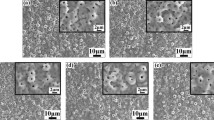Abstract
A nanostructured ternary coating of Ti/(Ru + Ti + Ce)O2 was prepared by the conventional electrodeposition on the titanium substrate as the cathode with different numbers of coating layers. The main objective of this work was to study nanostructured coatings of ceramic materials. For this purpose, the amount of precursor materials in the electrolyte was a variable parameter. Furthermore, the salt of TiCl4/RuCl3·xH2O/Ce(NO3)3·6H2O with different amounts, hydrogen peroxide, methanol, and distilled water were used as an aqueous–unaqueous bath. In addition, the coated samples were put to heat at 300, 450, 650, and 850 °C in an electric furnace for 1 h. The crystalline phase of the coating was characterized by X-ray diffraction (XRD). The chemical composition and microstructure of the coating were studied using energy-dispersive spectroscopy (EDS) and scanning electron microscopy analysis (SEM). Moreover, the electrochemical measurement of Ti/(Ru + Ti + Ce)O2 coatings was carried out. Results show that with the increase in the number of coating layers, the quality of morphology is improved. Then, the best quality of coatings is obtained at six layers on the titanium substrate with electrolyte including TiO2/RuO2/CeO2 with the molar ratio of 70:5:25 after heat treatment at 450 °C for 1 h. Besides, with the increase in CeO2 content from 5 wt% to 25 wt% and the number of coating layers, higher thickness of about (20.0 ± 0.1) µm and minimum over potential for chlorine evolution were obtained.











Similar content being viewed by others
References
Beer HB. The invention and industrial development of metal anodes. J Electro Soc. 1980;127(8):303c.
Trasatti S. Electrocatalysis: understanding the success of DSA. Electrochim Acta. 2000;45(15–16):2317.
Ann C, Bo H, Goran L. Ruthenium based DSA in chlorate electrolysis—critical anode potential and reaction kinetics. Electrochim Acta. 2003;48(5):473.
Tang D, Wen S, Chen SH. Preparation and characterization for a RuO260 %–TiO240 % nanomaterial. Trans Mat Heat Treat. 2000;21(3):12.
Panić CV, Dekanski A, Milonjić S, Atanasoski R, Nikolić B. The influence of the aging time of RuO2 sol on the electrochemical properties of the activated titanium anodes obtained by sol-gel procedure. Mater Sci Forum. 2000;352:117.
Teng ZH, Tang D. Synthesis and characterization of nanoscale Ce(x)Ru(1 − x)O2 coatings with electrochemical activity. J Am Ceram Soc. 2007;90(3):989.
Ribeiro J, DeAndrade AR. Characterization of RuO2Ta2O5 coated titanium electrode microstructure, morphology, and electrochemical investigation. J Electrochem Soc. 2004;151(10):D106.
Mraz R, Krysa R. Long service life IrO2/Ta2O5 electrode for electroflotation. J Appl Electrochem. 1994;24(12):1262.
Roberta DC, Fernando ST, Ribeiro J, Adalgisa RA. Effect of solvent on the preparation and characterization of DSAR-type anodes containing RuO2–TiO2–SnO2. J Braz Chem Soc. 2006;17(4):771.
Alves V, Silva LAD. Surface characterisation of IrO2/TiO2/CeO2 oxide electrodes and Faradaic impedance investigation of the oxygen evolution reaction from alkaline solution. Electrochim Acta. 1998;44(8–9):1525.
Song YS, Lee DY, Kim BY. Effect of glass frit addition on corrosion resistance of Ti/TiO2/IrO2–RuO2 films. Mater Lett. 2004;58(5):817.
Takasu Y, Onoue S, Kameyama K, Murakami Y, Yahikozawa K. Preparation of ultrafine RuO2–IrO2–TiO2 oxide particles by a sol-gel process. Electrochim Acta. 1994;39(13):1993.
Santana MHP, Silva LM, Faria LA. Investigation of surface properties of Ru-based oxide electrodes containing Ti, Ce and Nb. Electrochim Acta. 2003;48(13):1885.
Wendt H, Kreysa G. Electrochemical Engineering Science and Technology in Chemical and Other Industries. Berlin: Springer; 1999. 342.
Shrivastava P, Moats MS. Wet film application techniques and their effects on the stability of RuO2–TiO2 coated titanium anodes. J Appl Electrochem. 2009;38(1):7.
Mohammadi MR. Nanostructured TiO2–CeO2 mixed oxides by an aqueous sol-gel process: effect of Ce:Ti molar ratio on physical and sensing properties. J Sens Actuators B. 2010;150(2):631.
Yuosefpour M, Shokohi A. Electrodeposition of TiO2–RuO2–IrO2 coating on titanium substrate. J Superlattices Microstruct. 2012;54(6):842.
Acknowledgments
This work was financially supported by the Semnan University Foundation of Iran.
Author information
Authors and Affiliations
Corresponding author
Rights and permissions
About this article
Cite this article
Peyghambari, S.M., Yousefpour, M. Electrodeposition of nanostructured Ti/(Ru + Ti + Ce)O2 coatings. Rare Met. 37, 13–20 (2018). https://doi.org/10.1007/s12598-015-0683-2
Received:
Revised:
Accepted:
Published:
Issue Date:
DOI: https://doi.org/10.1007/s12598-015-0683-2




